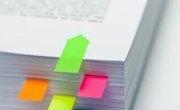Educational psychologist Benjamin Bloom identified categories of learning that are sometimes referred to as “the goals of the learning process.” He ordered them from the simplest behavior to the most complex. In 1956, Bloom published "Taxonomy of Educational Objectives, Handbook I: The Cognitive Domain," outlining that order. His order of learning behaviors is called Bloom’s Taxonomy, from the title of his influential publication. Since Bloom’s Taxonomy is widely referenced in the educational community, knowing how to cite it in American Psychological Association (APA) format is important for anyone writing a research paper for an education or psychology class.
Bloom's Order of Learning Behaviors
Before referencing in APA style, it is helpful to know the six learning behaviors of Bloom's Taxonomy as creating, evaluating, analyzing, applying, understanding and remembering. Additionally, the three named learning domains are cognitive, affective and psychomotor. These behaviors and learning styles are often part of psychology class papers making APA style citation relevant.
Obtain Bloom's "Taxonomy"
Locate a copy of Bloom’s "Taxonomy of Educational Objectives, Handbook I: The Cognitive Domain." Most academic libraries carry multiple copies, since it is such a widely referenced book. You can find all the information you need to reference Bloom’s Taxonomy on the copyright page.
In-Text Citations
Complete any in-text citations necessary. Any time you make reference to Bloom’s Taxonomy specifically or to something found within the book, whether paraphrasing or directly quoting, you must indicate the reference in your paper. In APA format, in-text uses author-date format. When referencing the entire work or an idea from Bloom’s Taxonomy, your citation does not need a specific page number. If you’re quoting directly or paraphrasing you must include page numbers. In-text citations for Bloom’s Taxonomy look like (Bloom, 1956) or (Bloom, 1956, p. 200). Reprinted editions of books require both publication years in the in-text citation with the author followed by the original publishing date/consulted version publishing date in this format (Bloom, 1956/2001).
Bibliography
List the reference on your bibliography or works cited page. Create a reference listing, using the publication information on the copyright page of your copy of Bloom’s book. Reference listings include the author’s name, year of publication, title of work, publication location and publisher in the following format: Author, A. A. (Year). Title. Location: Publisher. (Original publication date, if any). For example, a reference listing for the original publication of Bloom's book looks like this: Bloom, B. S. (1956). "Taxonomy of Educational Objectives, Handbook I: The Cognitive Domain." New York: David McKay Co Inc.
Related Articles
References
- Purdue OWL: APA Formatting and Style Guide: In-Text Citations
- Purdue OWL: APA Formatting and Style Guide: Reference List: Books
- Big Dog and Little Dog's Performance Juxtaposition: Bloom's Taxonomy of Learning Domains
- Western Washington Univeristy: Q. When using APA Style, what do I do when there is more than one date for a book?
Resources
Writer Bio
Sean Butner has been writing news articles, blog entries and feature pieces since 2005. His articles have appeared on the cover of "The Richland Sandstorm" and "The Palimpsest Files." He is completing graduate coursework in accounting through Texas A&M University-Commerce. He currently advises families on their insurance and financial planning needs.










